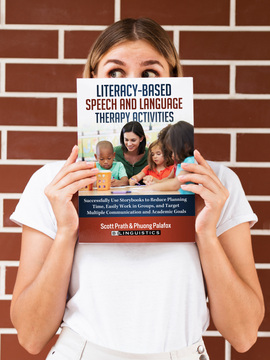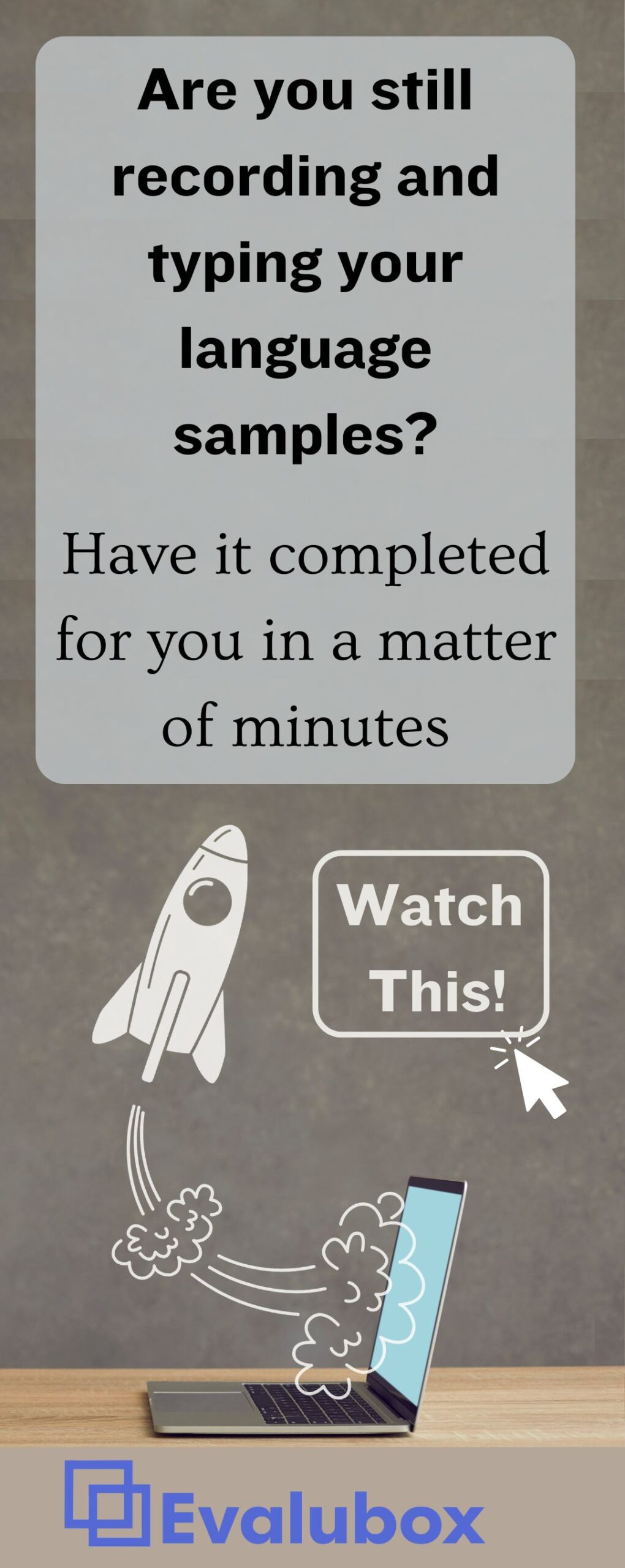Have you ever thought about why we test for a receptive and expressive language disorder pretty evenly but favor expressive language in our therapy? And how about our goals? Even when a child has a mixed receptive expressive language disorder, why do we focus so much less on the receptive language goals?
In this essay we are going to talk about all the reasons a focus on receptive language goals is powerful and can even promote expressive language growth! And, at the end we have included some of the best IEP goals for receptive language in English and Spanish.

Are Your Receptive Language Testing and Intervention Balanced?
Here’s something that I have always thought was kind of strange: When we test language we approach both expressive and receptive language testing in a pretty balanced way. It doesn’t matter which formal tests you’re using. It doesn’t matter if you’re doing informal tests or collecting a language sample. We write great goals to support our findings. But then in therapy, where do we spend most of our time?
While our evaluations evenly test expressive and receptive abilities, where do we spend our time when a child is diagnosed with both expressive language disorder and receptive language disorder?
I would say that I, early on in my career, and many speech pathologists spend the bulk of their time on expressive language therapy. This also bears out if you are to go on the internet just looking for speech therapy materials for receptive language. It’s completely unbalanced and the materials that are out there aren’t always tied to the curriculum.
So I hear you saying: Maybe expressive language is just more important and where we should be putting our efforts? Here are five reasons to give your receptive language objectives a bigger share of your time.
Why Should We Be Focusing on Receptive Language Goals?
1. If a child can attend, then he is more likely to remember and produce expressive language.
If a child can attend, he is more likely to remember and produce expressive language. Basically, we need to understand what it is that’s being asked of us in order for us to produce something that’s coherent.
With typical development and even bilingual development, growth is dependent on understanding what it is that we’re supposed to deliver. This is even more important when we have a mixed receptive expressive language disorder. When a child’s output is smaller, they really need to know exactly what you want so that their limited one or two words are more effective.
2. Receptive language is larger than expressive language.
Think about all the words that you know or that you can read versus which words you use on a daily basis. This isn’t even a special education issue. How different is your expressive vocabulary in comparison to everything that you might see on the internet or in your news articles or everything you’d read like in a scientific journal?
No one knows for sure but our receptive language vocabulary is estimated to be five times greater than the number of words we typically use.
3. Attention deficits and poor vocabulary acquisition are two of the most common referral concerns.
When we’re talking about children who have multiple disabilities, this really bears out both in the literature and in our experience in the classroom. When children have attention deficit or poor vocabulary acquisition, the their understanding in the classroom setting is reduced.
A teacher’s job is to prove learning. They teach a bunch of stuff. They get feedback as to whether it worked or not. They might teach an additional lesson, or they might move on. If a child doesn’t “receive” what is taught, is it because of:
- An attention deficit
- Second-language limitations
- A receptive language deficit
- All of the above
All the teacher knows is that the child didn’t retain/remember/respond at the same rate as their general education peers. And this is where we come in because focusing on receptive language can address all of the issues collectively and help the child achieve and demonstrate learning.
4. If a child is in the early stages of bilingualism, there is an increase in processing time.
A child in the early stages of learning a second language needs more processing time. This makes sense, right? For those of you that studied a second language, think about a trip to a restaurant where that language was spoken or maybe another country on a trip.

Someone says something and you don’t quite understand. You’re on high alert, right? All of a sudden, you have SpiderMan-like hearing. You’re focused in and your eyes are dilated. The rest of the room goes black and all of your senses are heightened. It’s in these instances that we are truly paying attention, truly receptive.
And it’s really exciting too when you get that taco! When you actually get the food that you ordered!
Well, if we flip that around and we do receptive therapy that leans in heavily on all of the senses, not just hearing, not just the ears, we get better retention and better comprehension.
5. Long term receptive language goals have additional therapeutic benefits
Digging through the research, there are just tons and tons of therapeutic benefits to focusing on the comprehension abilities of a child. Here are a few:
- Engage effectively in an academic setting
- Retell past events, sequence ideas, and answer questions appropriately
- Understand and respond appropriately to questions
- Develop an understanding of concepts
- Improve reading and writing skills
- Develop alternative forms of communicating (e.g. signing)
- Help reduce frustration
This list looks a lot like many of the referral concerns that we see on a daily basic coming from teachers. Hopefully you see the point of leaning into your SLP receptive language goals. Now we just need to know which ones are effective. Here are some of our favorites.
Receptive Language Goals for Vocabulary
- Will increase understanding of age-appropriate receptive vocabulary
- – Identify #-unique nouns by pointing to pictures
- – Identify #-unique action verbs by pointing to pictures
- – Identify #-unique adjectives by pointing to pictures (size/shape/color/texture, etc.)
- Aumentará conocimiento de vocabulario receptivo apropiado para su edad
- – Identificar #-sustantivos, señalando a fotos
- – Identificar #-verbos, señalando a fotos
- – Identificar #-adjetivos, señalando a fotos (tamaño/forma/color/textura, etc.)
- Will identify word-relationships
- – Identify parts of a whole by pointing to pictures/objects
- – Identify category members by grouping items/pointing to pictures
- – Complete analogies by pointing to a picture
- Identificará las relaciones entre palabras
- – Identificará partes de un entero, señalando a fotos/objetos
- – Identificará miembros de una categoría, juntando objetos/señalando a fotos
- – Completará analogías semánticas, señalando a fotos
- Will identify age-appropriate concepts by pointing to pictures/objects
- – Identify color concepts by pointing to pictures/objects
- – Identify size concepts by pointing to pictures/objects
- – Identify shape concepts by pointing to pictures/objects
- Identificará conceptos apropiados para su edad, señalando a fotos/objetos
- – Identificará conceptos de color, señalando a fotos/objetos
- – Identificará conceptos de tamaño, señalando a fotos/objetos
- – Identificará conceptos de forma, señalando a fotos/objetos
Receptive Language Goals for Answering Questions
- Will answer age-appropriate ‘yes/no’ questions related to a variety of contexts
- – Personal experiences
- – Classroom discussions
- – Stories
- Contestará preguntas de ‘si/no’ apropiados para su edad en relación a una variedad de contextos
- – experiencias personales
- – discusiones en el salón
- – cuentos
- Will answer age-appropriate wh- questions in a variety of contexts
- – Answer age-appropriate wh- questions related to a story
- – Answer age-appropriate wh- questions related to an activity
- – Answer age-appropriate wh- questions related to discussion
- Contestará preguntas apropiadas para su edad en una variedad de contextos
- – Contestará preguntas apropiadas para su edad, sobre un cuento
- – Contestará preguntas apropiadas para su edad, sobre una actividad
- – Contestará preguntas apropiadas para su edad, sobre discusiones
- Will answer a variety of age-appropriate wh- question types
- – Answer ‘who’ questions
- – Answer ‘what’ questions
- – Answer ‘when’ questions
- – Answer ‘where’ questions
- – Answer ‘why’ questions
- Contestará una variedad de preguntas apropiados para su edad
- – Contestará preguntas de “quien”
- – Contestará preguntas de “que”
- – Contestará preguntas de “cuando”
- – Contestará preguntas de “donde”
- – Contestará preguntas de “porque”
Receptive Language Goals for Following Directions
- Will follow #-step directions
- – Follow 1-step directions
- – Follow 2-step directions
- – Follow 3-step directions
- Seguirá instrucciones de #-paso
- – Seguirá instrucciones de 1-paso
- – Seguirá instrucciones de 2 pasos
- – Seguirá instrucciones de 3 pasos
- Will follow #-step directions with age-appropriate modifiers
- – Location (e.g., spatial concepts)
- – Quantity (e.g., number, more/less)
- – Quality (e.g., size, color, shape)
- – Pronouns
- Seguirá instrucciones de # pasos que incluyen conceptos descriptivos apropiados por su edad
- – Conceptos de ubicación (en frente, atrás, arriba, abajo etc.).
- – Conceptos de cantidad (todos, ninguna, algunos etc.)
- – Conceptos de cantidad (tamaño, color, forma)
- – Pronombres (el, ella, tuya, mío, etc.)
Just add the percentage and support to the end and you are good to go: …in 7/10 opportunities with minimal/moderate/maximal support.
For more speech-language goals, be sure to bookmark the Bilinguistics Goal Bank.
Learn More:
Receptive Language Disorders and Delays – Share this with your parents
The 6 Most Productive Receptive Language Activities
A New Approach for Receptive Language Strategies
The Power of Receptive Language – Earn CEUs and improve your receptive language game!






I love getting ready to go goals!!
Thanks, Scott
Is there a printable version of this blog post?
Hi Holly,
Depending you your computer you can print most webpages by right-clicking. However, most people bookmark the page because we are constantly updating and then you get the best info. Same with the goals. If it is the goals that you want to remember, check out our Goals page because the Receptive Language Goals are there along with all all sound and language disorder classes. Just book mark it: Speech Therapy Goals Or if you Google speech therapy goal bank it is usually at the top.